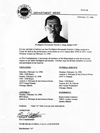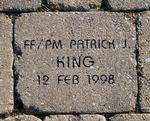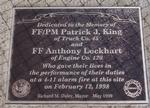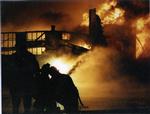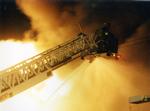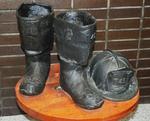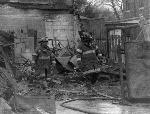Firefighter Record
Firefighter Details
| Name | Patrick King |
| Agency | Chicago Fire Department |
| Rank | Firefighter |
| Type of Firefighter | Career |
| Age Range | 36 to 40 |
| Sex | Male |
| Date of Birth | 2/24/1957 |
| Date of Death | 2/11/1998 |
| Cause of Death | Caught/Trapped , Contact/Exposure |
| Nature of Death | Asphyxiation |
| Attribute of Death | Smoke inhalation |
| Type of Duty | Firefighting operations , Hose operations |
Incident Details
| Incident Name | N/A |
| Incident City | Chicago |
| Incident State | IL |
| Incident Date | 2/11/1998 22:24 |
| Incident Location | Store/Office |
| Incident Attribute | Structural collapses , Backdrafts , Fires |
Incident Summary
On February 11, 1998, at 10:24 PM, the Chicago Fire Department received a call from the occupant of a private residence at the rear of a commercial tire service center, stating there was a fire in the interior of the building. The service center was constructed of masonry block with a brick facade on a concrete slab foundation. The center measured 150 feet wide by 62 feet in depth, with a glass showroom attached to the front, measuring 75 feet by 55 feet. Above the parts room was a cockloft (unfinished area below the roof), where tires, Christmas decorations, and miscellaneous items were stored (believed to be the area of origin of the fire). The cockloft was accessible from the service area. The roof system of the service area was constructed of open wooden bow-string trusses, with unprotected polystyrene insulation glued to the underside. The exterior of the roof was a rubberized material, which had recently been repaired. The entrance to the service area was either through a standard passage door from the showroom into the service area, or through an exterior metal garage door, which was raised and lowered by an electric automatic motorized system.
Those units responding initially were Engine 92 with a lieutenant, engineer, and 2 firefighters, Engine 120 with a lieutenant, engineer, and 3 firefighters, Truck 24 with a lieutenant and 4 firefighters, Truck 45 with a lieutenant and 4 firefighters, and Battalion 21. Firefighter Anthony Lockhart responded with Engine 120 and Firefighter Patrick King responded with Truck 45. At 10:28 PM, Engine 120 was the first company to arrive at the service center, with Engine 92 being the second company on the scene, then Truck 45, Truck 24, and Battalion 21. None of the firefighters reported seeing any fire or smoke, so one of the firefighters radioed back to dispatch to verify the address. The address was confirmed by dispatch, and at the same time a neighbor told the firefighters he saw fire at the rear of the building.
At approximately 10:30 PM, the owner of the business arrived to unlock the front door to the showroom. Approximately 8 to 10 firefighters from the first-arriving companies, including King and Lockhart, entered the showroom; some firefighters reported no smoke showing, others reported observing a light haze in the showroom, with the odor of a burning car. They opened the door to the service area, where black smoke covering the top one-third of ceiling space was encountered. They entered with a charged 1 3/4-inch hose line, which was connected to a 2 1/2-inch leadout line. The lieutenant from Engine 120 walked deep into the service area along the wall to the South in an attempt to locate the light switch panel. The firefighters indicated that at no time did any them feel any excessive heat or see any fire.
When the firefighters entered the building, two firefighters from Truck 45 in front of the building, and two firefighters from Truck 24 went to the rear of the building. They ascended ground ladders to the roof to cut ventilating holes in the roof with axes. The firefighters on Truck 24 stated that there was no smoke or fire showing when they arrived at the rear of the building; however, they noticed the windows were dark and smoky. One firefighter punched a small hole in one window with an axe tip, and black smoke billowed out. This was seen and heard by the truck lieutenant inside doing his survey in the service area. Within 5 to 8 minutes, the four firefighters on the roof had chopped a ventilation hole, approximately 4- or 5-foot square. When they peeled back the opening, black smoke was emitting from the hole. However, within 30 seconds, flames also started roaring up through the opening. All four firefighters immediately picked up their equipment and descended the ladders to the ground.
At approximately 10:43 PM, the 8 to 10 firefighters and officers who were inside the building had advanced some 15 to 20 feet into the service area where thick black smoke was above them. They reported running into each other because of the poor visibility. At approximately 10:45 PM, without warning, hot gases that had accumulated along the 20- foot-high ceiling ignited, causing a backdraft situation. This created a pressure wave, knocking the firefighters off balance and to the floor (it is conceivable that just before the time of ignition, the overhead garage door into the service area was self-activated and raised, allowing additional air to fuel the fire - this was determined by an examination by the city electrical inspector and an electrical engineer that the motor and drive chain assembly had definitely opened electrically as a result of the fire shorting out the low voltage side of the switch wires). The firefighters became disoriented, could not find the hose, and were scrambling and yelling in an attempt to escape the inferno they had been caught in. Additionally, the molten polystyrene insulation from the ceiling area began falling down on them. One firefighter later reported that he could hear his fellow firefighters running into and knocking over things, yelling, and screaming, trying to escape from the burning structure. One firefighter dove through the office window to escape the burning building. The escape from the service area was complicated by the 20 cars stored in the service area, the intense heat, heavy black smoke, disorientation and panic from being trapped.
When the firefighters exited the burning structure, an immediate head count was taken, and it was discovered that King and Lockhart were missing. Rescue attempts by firefighters to reenter the structure were numerous but futile, as the entire service area became fully involved with fire, prohibiting entry and rescue the missing fire fighters. Within 30 minutes, the entire truss roof collapsed into the structure. Once the fire was extinguished, King and Lockhart were removed from the scene and transported to Little Company of Mary’s Hospital Emergency Room by Ambulance 27 and Ambulance 17. Lockhart was pronounced dead-on-arrival at 1:24 AM, while King was pronounced dead-on-arrival at 1:32 AM.
Summary adapted from reports by the Chicago Fire Department and the National Institute for Occupational Safety and Health.
Additional Resources:
http://www.cdc.gov/niosh/fire/reports/face9805.html
